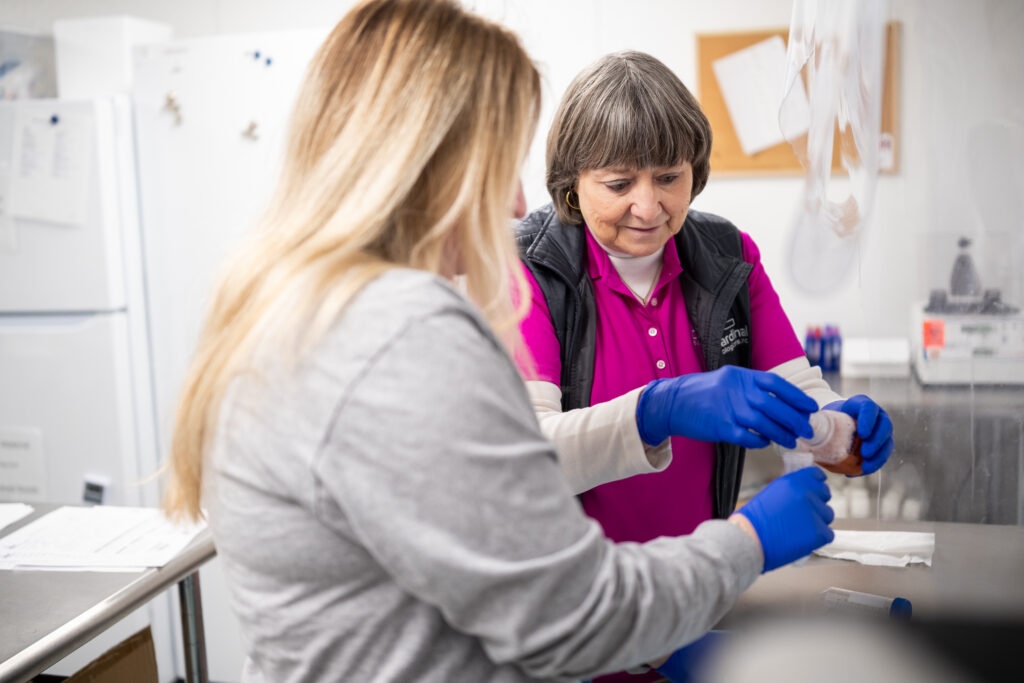What if, after giving birth to your healthy baby, you could also help heal people suffering from chronic wounds, help athletes recover from sports injuries and advance arthritis research? And all through donating birth tissue that would otherwise be thrown away.
With the help of Cardinal Biologicals, a company that repurposes non-transplantable human biological material to advance medical research and its applications, you can.
“We liken it to going to the Red Cross and donating blood or being an organ donor,” says Paul Pfeiffer, Cardinal Biologicals president and CEO. “It’s essentially for the goodwill of research, to help your fellow human beings.”
Cardinal Biologicals, Inc. was founded in Tyler, Texas, in 1988. Pfeiffer bought the company and relocated it to Cape Girardeau in 2019.
Since, the donated birth tissue, which includes the placenta, amniotic sac and umbilical cord, have enabled the advancement of breast cancer research. The placental skin called the amnion chorion, which surrounds the placenta to keep it safe and is rich in stem cells, is also used to manufacture amniotic membrane patches (AMPs), which help to heal the mouth after dental surgeries, as well as burns and chronic wounds such as diabetic foot ulcers and surgical wounds; since the amniotic membrane patches are 100% all-natural and hypoallergenic, the body does not reject them like it sometimes rejects synthetic dermis.
Other applications include sports injuries, eye injuries and spinal surgeries. Research is also being done on Wharton’s jelly, a viscous fluid found in the umbilical cord, with applications for osteoarthritis and rheumatoid arthritis treatments.
If not donated or used by the patient, the birth tissue is usually discarded by hospitals. Donating their baby’s birth tissue is an opportunity offered to mothers delivering their babies at local hospital partners after mothers have delivered full-term, healthy babies, the only type of birth tissue accepted as donations by Cardinal Biologicals.
At the hospital, a mother delivering her baby will be informed by a nurse of the opportunity to donate birth tissue and can choose to donate any combination of the placenta, umbilical cord and amniotic fluid. If she decides to donate, she will fill out a consent form, medical release form and donor risk assessment questionnaire. At the time of IV placement, nurses will draw extra tubes of blood for testing. After the delivery, if the baby and mother are both healthy, the donated birth tissues will be collected and stored in a refrigerator at the hospital for transport to the laboratory. Mothers can pre-register to donate at birthgift.org, although this step is not mandatory.
“It’s just taking that gift of life and extending it to patients outside of the hospital room,” Pfeiffer says.
The National Organ Transplant Act of 1984 (NOTA) outlaws the sale or purchase of tissue. Once donated, patient information is de-identified and stored securely, while each placenta is given a donor ID number. The Food and Drug Administration (FDA) heavily regulates the process from donation to manufacturer.
Pfeiffer compares birth tissue donation to donating blood or giving items that are no longer needed to Goodwill: It’s low-risk/no-risk for the mother and baby, and it benefits their neighbors in a worthwhile way. The local hospitals that collect the birth tissue are also the ones that use the amniotic membrane patches to treat their patients; Pfieffer calls it a full-circle gift.
“Not only are you bringing a new life into the world, but you’re able to help somebody who has been suffering with a chronic wound for months, years,” Pfeiffer says. “This is one of the happiest moments of a mother’s life. Why not extend that gift beyond you and your baby to your neighbors, to the larger community?”
Cardinal Biologicals
821 Progress St.
Cape Girardeau
(573) 398-7655
info@cardinalbiologicals.com
www.cardinalbiologicals.com



